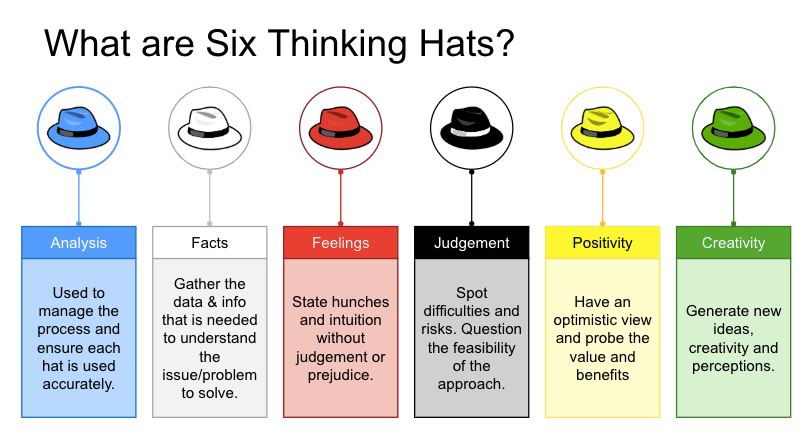How We Aligned on Product Strategy and Moved Forward Together
Using the Six Thinking Hats Method to for Clarity and Collaboration
We had a problem. Our product and business teams weren’t fully aligned on customer pain points, and the product strategy felt like it was being developed in isolation. Despite recurring meetings over several months, we couldn’t dive deep enough to close the gaps. Misalignment on metrics, priorities, and user experience meant we risked building in the wrong direction.
I knew we needed more than just another status meeting. We needed to get everyone in the same room, thinking clearly about the same problems, and moving toward shared outcomes. So I designed and facilitated a 2.5-day workshop aimed at breaking through this disconnect.
Last week, our team came together for an offsite to tackle the challenges holding us back. Our goal was to align on four critical areas: customer pain points and product strategy, success metrics, roadmap priorities, and user experience vision.
How We Created a Shared Lens for Strategy Discussions
To make sure the conversation stayed structured and productive, I introduced Edward de Bono’s Six Thinking Hats framework - not as a gimmick, but as a practical tool to keep us focused.
I also built an AI agent based on the Six Thinking Hats as an icebreaker. This helped the group get comfortable with the framework before applying it to our real product challenges.
We tackled each goal one at a time. For example:
White Hat: Grounded ourselves in facts: customer pain points, competitive research, and existing product strategy.
Black Hat: Surfaced risks, like confusing flows spotted in competitor products.
Yellow Hat: Drew out the benefits and strengths of potential approaches.
Green Hat: Unlocked new ideas - even for experiences we initially thought were “good enough.”
Red Hat: Created a safe space to air out feelings.
When we got to roadmap alignment, I guided the group through a Now / Next / Later prioritization exercise. This made trade-offs visible and gave us a realistic sequence of what to tackle first without losing sight of longer-term opportunities.
For the UX goal, we skipped the hats and worked collaboratively to review existing designs. We spotted gaps, explored real-time scenarios, and made live updates together. This hands-on approach helped us quickly identify what needed refinement and what was ready to go.
This approach gave everyone clarity about which lens we were using at any given time, reducing unproductive back-and-forth.
What Made the Difference
Several things turned this from just another workshop into a turning point for our strategy:
Competitive analysis didn’t just inspire us but also warned us about what not to do.
Risks identified during Black Hat thinking directly inspired Green Hat innovation.
The structure gave quieter voices equal footing, improving idea quality.
Ground rules (I call these “Team agreements”) and a smaller group created psychological safety for candid discussions.
The Now / Next / Later framework gave the team a clear, achievable, and strategically aligned roadmap.
Live UX collaboration turned abstract feedback into tangible improvements on the spot.
The Outcome
By the end of the two days, everyone, even those closest to the strategy, walked away with more clarity. We agreed on the customer pain points, established metrics for success, prioritized our roadmap in terms of Now / Next / Later, and refined our UX approach.
Most importantly, the team left energized and empowered to make decisions without second-guessing whether others were aligned. For me, it was rewarding to see that the structured approach I designed not only achieved our goals but also built momentum for the months ahead.
Lessons For Product Leaders
If you’re a product leader facing alignment challenges, don’t underestimate the value of structured conversation. The Six Thinking Hats is one way to do it, but the real key is creating the conditions for deep, honest, and focused discussion. When you do, you can turn months of unclear meetings into a few days of decisive progress. To make it work:
Establish psychological safety from the start.
Set clear, measurable goals.
Keep the group small for deeper participation.
The biggest benefit for us was reducing ambiguity. The energy in the room carried forward, empowering people to make confident decisions after the session.
Conclusion
This experience showed me the power of intentional, structured collaboration to break through misalignment. When product teams commit to open, focused dialogue with clear tools and goals, they can turn months of unclear meetings into days of decisive progress. If you’re facing similar challenges, I encourage you to try these approaches and see what breakthroughs they unlock for your team.

